Tensile Creep Model of Slab Concrete Based on Microprestress-Solidification Theory
Abstract
1. Introduction
2. Materials and Methods
2.1. Materials and Mix Proportions
2.2. TSTM Test
3. Results and Discussion
3.1. Properties of Fresh Concrete Mixes Studied
3.2. Development Curves under Different Temperature Curing Modes
3.3. Tensile Creep under Different Temperature Curing Modes
4. Improved Tensile Creep Models
4.1. The Kelvin Model Based on Degree of Hydration
- The elastic unit:where E(ξ) is the modulus of elasticity based on the degree of hydration; εe is the strain of the elastic unit; E∞ represents the final modulus of elasticity; ξ(t) is the degree of hydration of the concrete at time t; ξ0 is the permeability threshold, generally taken as 0.1 [25], and we selected the degree of hydration corresponding to the initial setting time in this paper; ξ∞ represents the final degree of hydration; and <·>+ represents the absolute value.
- The Kelvin units:where σ is the stress; σki and σηi are the stress of the elastic unit and viscous unit of the i Kelvin unit; εki is the strain of the i Kelvin unit; and ki(ξ) and ηi(ξ) are the function of the stiffness coefficient and viscosity coefficient of the i Kelvin unit with the development of hydration, and the value can be taken as follows [16]:where τi is the delay time of the i Kelvin unit and should meet a certain relationship [26]. In this paper, τ1 = 0.1 d, τ2 = 1 d and τ3 = 10 d.
- The viscous unit:where ηa(t) is the viscosity coefficient of the viscous unit, εa is the strain of the viscous unit, α is the coefficient of microcrack influence and ka is a constant.
4.2. Improved Kelvin Model Based on MPS Theory
4.3. The Degree of Hydration Curves
4.4. Calculation Parameters of Two Models
4.5. Verification of the Kelvin Model
4.6. Verification of Improved Kelvin Model under Variable Temperature
5. Conclusions
- In this study, the used expansive agent reduced shrinkage of slab concrete, delayed the appearance of the tensile stress and increased the cracking stress simultaneously, thus resulting in being beneficial to cracking resistance. The MgO expansion has little effect on creep and specific creep of concrete. In summary, the concrete mixed with MgO had better early age cracking resistance than the benchmark concrete.
- Two tensile creep models were proposed to predict the tensile creep development of slab concrete at early age accurately.
- Compared with the Kelvin creep model, the improved tensile creep model considering temperature variation has an obvious improvement in prediction accuracy. It preferably predicts the development of the early age tensile creep of slab concrete under variable temperature.
Author Contributions
Funding
Conflicts of Interest
References
- Mo, L.; Deng, M.; Tang, M.; Al-Tabbaa, A. MgO expansive cement and concrete in China: Past, present and future. Cem. Concr. Res. 2014, 57, 1–12. [Google Scholar] [CrossRef]
- Kabir, H.; Hooton, R.D. Evaluating soundness of concrete containing shrinkage-compensating MgO admixtures. Constr. Build. Mater. 2020, 253, 119141. [Google Scholar] [CrossRef]
- Mehta, P.K.; Pirtz, D. Magnesium Oxide Additive for Producing Self Stress in Mass Concrete. In Proceedings of the 7th International Congress on the Chemistry of Cement, Paris, France, 1 January 1980; pp. 6–9. [Google Scholar]
- Chen, C.; Li, C. Study and application of MgO concrete. Concrete 2006, 199, 45–47. (In Chinese) [Google Scholar]
- Chatterji, S. Mechanism of Expansion of Concrete Due to the Presence of Dead-Burnt CaO and MgO. Cem. Concr. Res. 1995, 25, 51–56. [Google Scholar] [CrossRef]
- Klausen, A.E.; Kanstad, T.; Bjøntegaard, Ø.; Sellevold, E. Comparison of tensile and compressive creep of fly ash concretes in the hardening phase. Cem. Concr. Res 2017, 95, 188–194. [Google Scholar] [CrossRef]
- Bažant, Z.P. Creep of Concrete. In Encyclopedia of Materials: Science and Technology; Buschow, K.H.J., Cahn, R.W., Flemings, M.C., Ilschner, B., Kramer, E.J., Mahajan, S., Veyssière, P., Eds.; Elsevier: Oxford, UK, 2001; pp. 1797–1800. [Google Scholar]
- Pane, I.; Hansen, W. Early age creep and stress relaxation of concrete containing blended cements. Mater. Struct. 2002, 35, 92–96. [Google Scholar] [CrossRef]
- Bazant, Z.P.; Wittmann, F.H. Creep and Shrinkage in Concrete Structure; John Wiley & Sons: Chichester, UK; New York, NY, USA, 1982. [Google Scholar]
- Zhang, T.; Qin, W. Creep of concrete at early age and its effecton cracking sensitivity. Ind. Constr. 2005, 35, 89–92. (In Chinese) [Google Scholar]
- Li, F.; Qin, W. Restraint stress and stress relaxation in concrete at early ages. J. Tsinghua Univ. (Sci. Technol.) 2010, 50, 363–366. (In Chinese) [Google Scholar]
- Zhang, G.; Tu, L.; Xia, W.; Liu, K.; Liu, B. Study on evaluation index of early ages cracking in concrete. Concrete 2005, 187, 13–17. (In Chinese) [Google Scholar]
- Bazant, Z.P.; Hauggaard, A.B.; Baweja, S.; Al, E. Microprestress-solidification theory for concrete creep. I: Aging and drying effects. J. Eng. Mech. 1997, 123, 1188–1194. [Google Scholar] [CrossRef]
- Bazant, Z.; Hauggaard, A.; Baweja, S. Microprestress-Solidification Theory for Concrete Creep. II: Algorithm and Verification. J. Eng. Mech. 1997, 123, 1195–1201. [Google Scholar] [CrossRef]
- Wei, Y.; Guo, W.; Liang, S. Microprestress-solidification theory-based tensile creep modeling of early-age concrete: Considering temperature and relative humidity effects. Constr. Build. Mater. 2016, 127, 618–626. [Google Scholar] [CrossRef]
- De Schutter, G. Degree of hydration based Kelvin model for the basic creep of early age concrete. J. Eng. Mech. 1997, 32, 260–265. [Google Scholar] [CrossRef]
- Wei, Y.; Liang, S.; Guo, W. Stress prediction of early-age concrete incorporating hydration degree-based tensile creep under restrained conditions. J. Build. Struct. 2016, 37, 162–168. (In Chinese) [Google Scholar] [CrossRef]
- Hilaire, A.; Benboudjema, F.; Darquennes, A.; Berthaud, Y.; Nahas, G. Modeling basic creep in concrete at early-age under compressive and tensile loading. Nucl. Eng. Des. 2014, 269, 222–230. [Google Scholar] [CrossRef]
- Kovler, K. Testing system for determining the mechanical behaviour of early age concrete under restrained andfree uniaxial shrinkage. Mater. Struct. 1994, 27, 324–330. [Google Scholar] [CrossRef]
- Zhao, Z.; Zhang, G.; Shi, T. Thermal expansion coefficient of ultra high content fly ash mass concrete at early age. J. Hydroelectr. Eng. 2019, 38, 41–48. (In Chinese) [Google Scholar] [CrossRef]
- Zhao, Z.; Wang, K.; Lange, D.A.; Zhou, H.; Wang, W.; Zhu, D. Creep and thermal cracking of ultra-high volume fly ash mass concrete at early age. Cem. Concr. Compos. 2019, 99, 191–202. [Google Scholar] [CrossRef]
- Chen, B.; Sun, W.; Ding, J. Concrete Crack Resistance Research Based on Temperature Stress Test—A Short Review. J. Chin. Ceram. Soc. 2013, 41, 1124–1133. (In Chinese) [Google Scholar]
- Hansen, P.F.; Pedersen, J. Maturity computer for controlled curing and hardening of concrete. Nord. Betong 1997, 1, 21–25. [Google Scholar]
- Ji, X.; Liu, M.; Xiang, F.; Rao, W.; Wang, H.; Liu, Y. Study on the Early-age Cracking Resistance of Concrete with Expansive Agent Using Temperature-stress Testing Machine. China Concr. Cem. Prod. 2020, 2, 14–18. (In Chinese) [Google Scholar] [CrossRef]
- Boumiz, A.; Vernet, C.; Tenoudji, F.C. Mechanical properties of cement pastes and mortars at early ages: Evolution with time and degree of hydration. Adv. Cem. Based Mater. 1996, 3, 94–106. [Google Scholar] [CrossRef]
- Bažant, Z.P.; Baweja, S. Creep and shrinkage prediction model for analysis and design of concrete structures-model B3. Mater. Struct. 1995, 28, 357–365. [Google Scholar] [CrossRef]
- Bažant, Z.P. Thermodynamics of interacting continua with surfaces and creep analysis of concrete structures. Nucl. Eng. Des. 1972, 20, 477–505. [Google Scholar] [CrossRef]
- Test Methods for Heat of Hydration of Cement GB/T 12959-2008. China Architecture and Building Press: Beijing, China, 2008. (In Chinese)

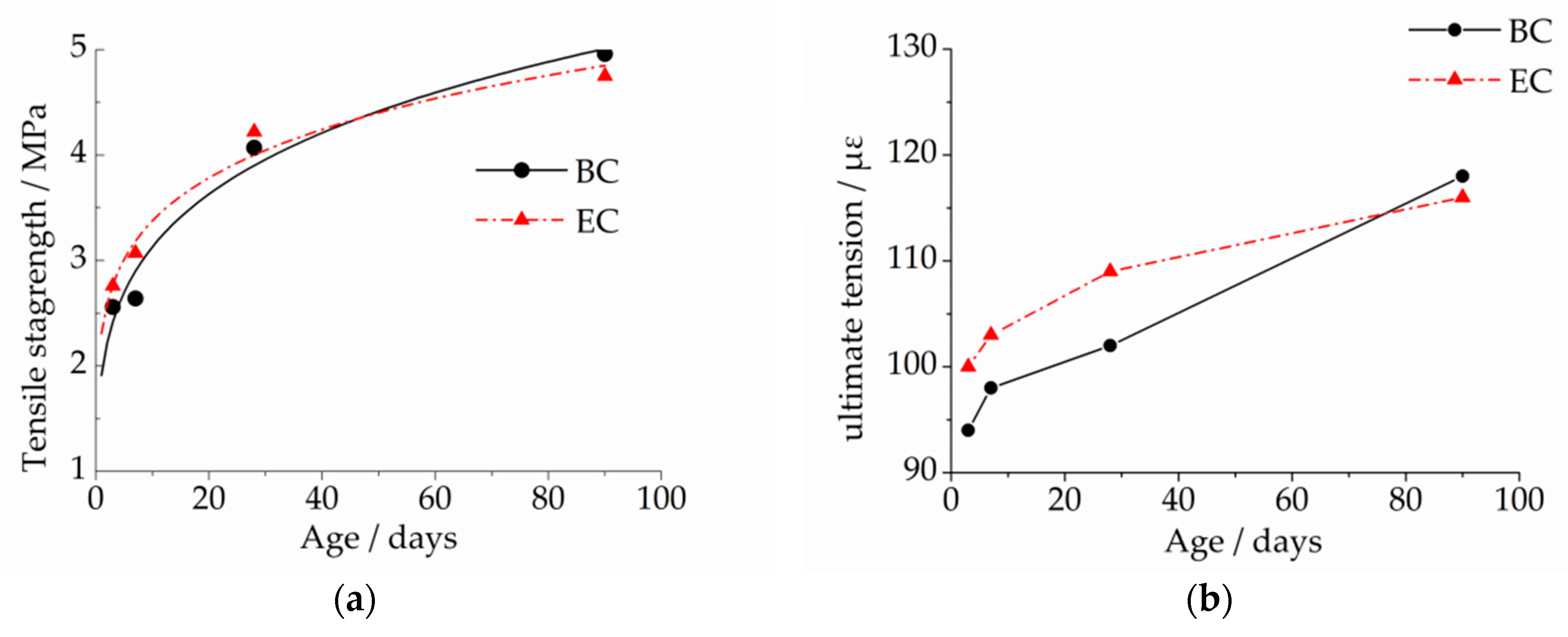

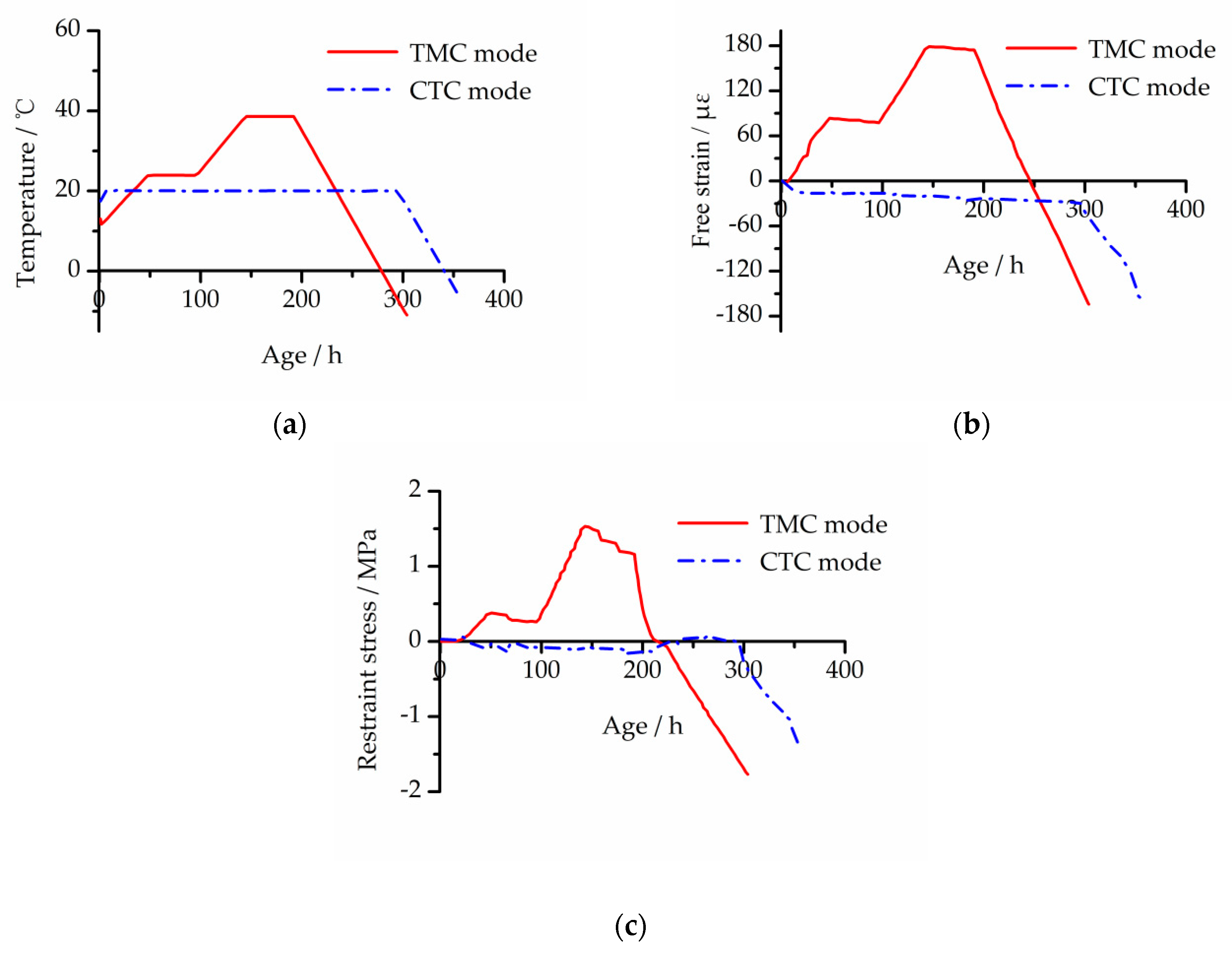
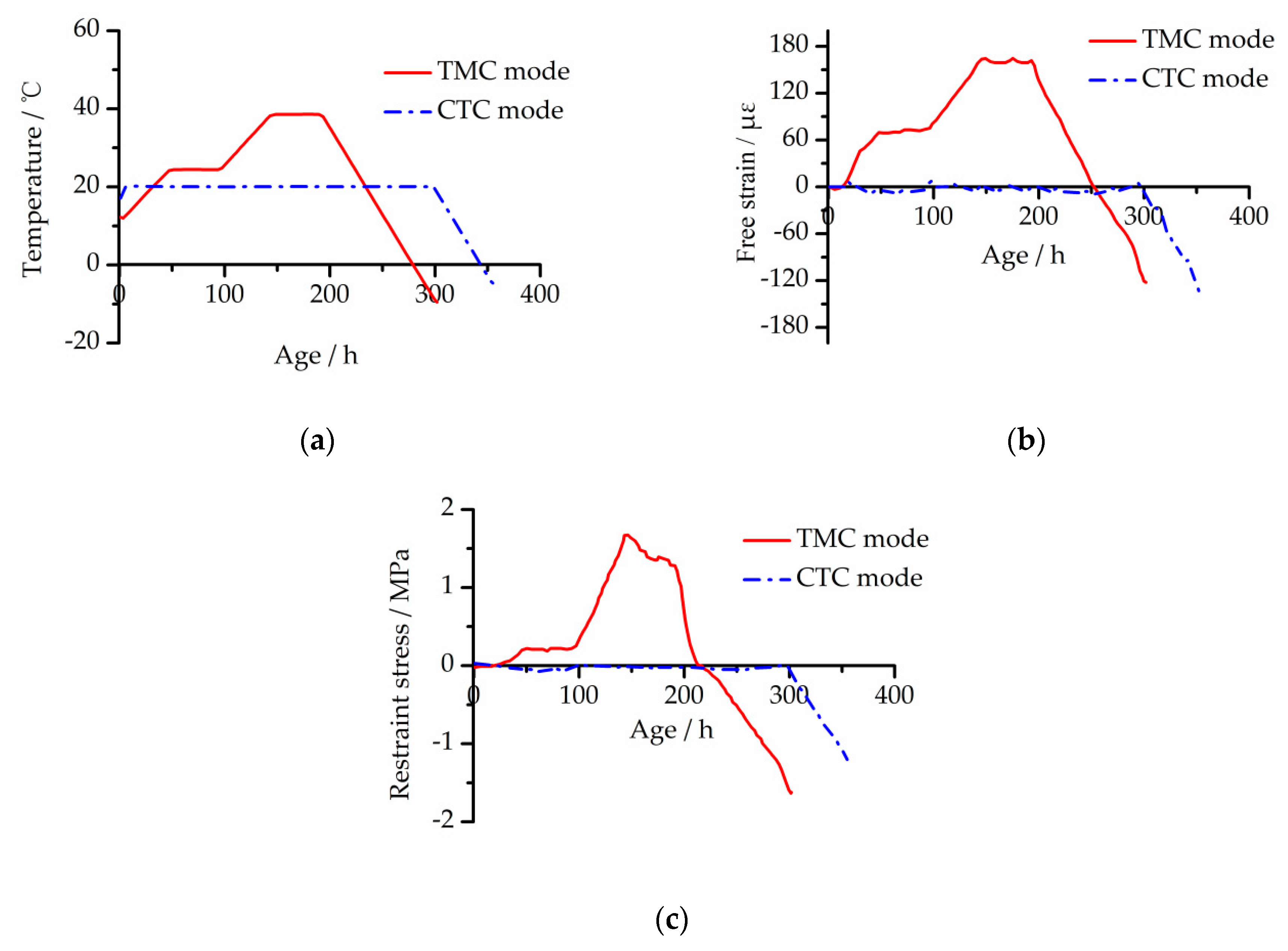
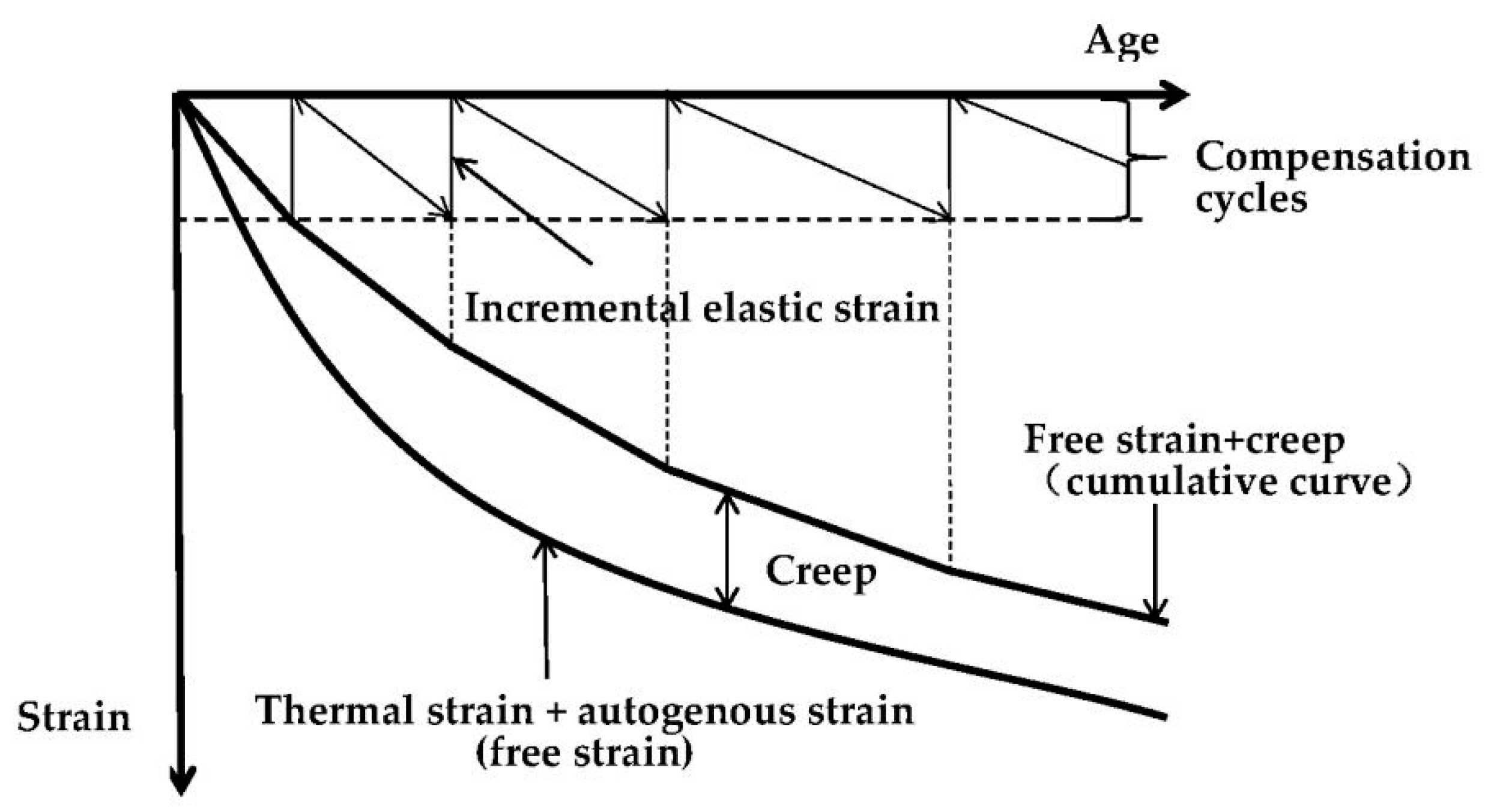
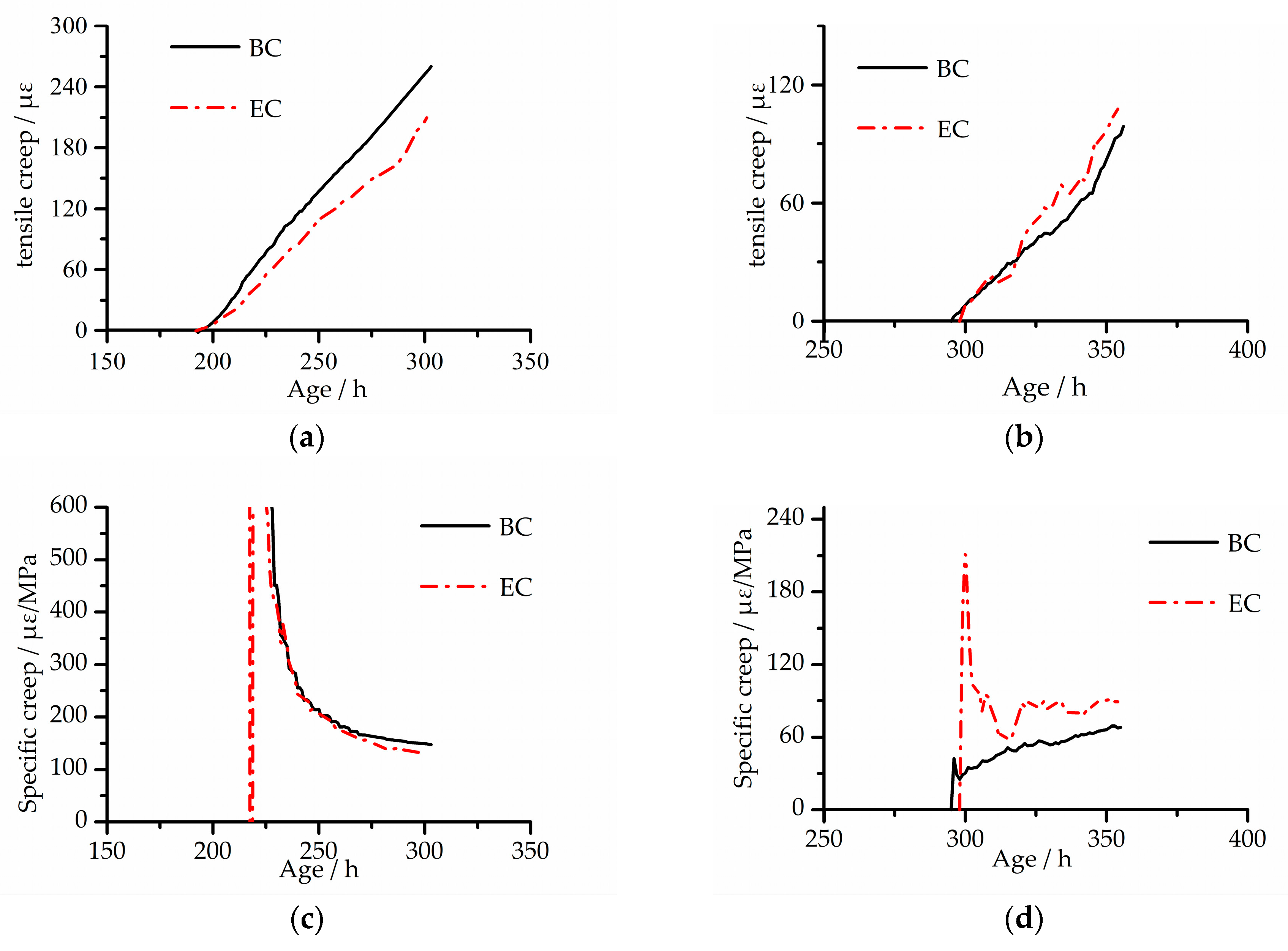
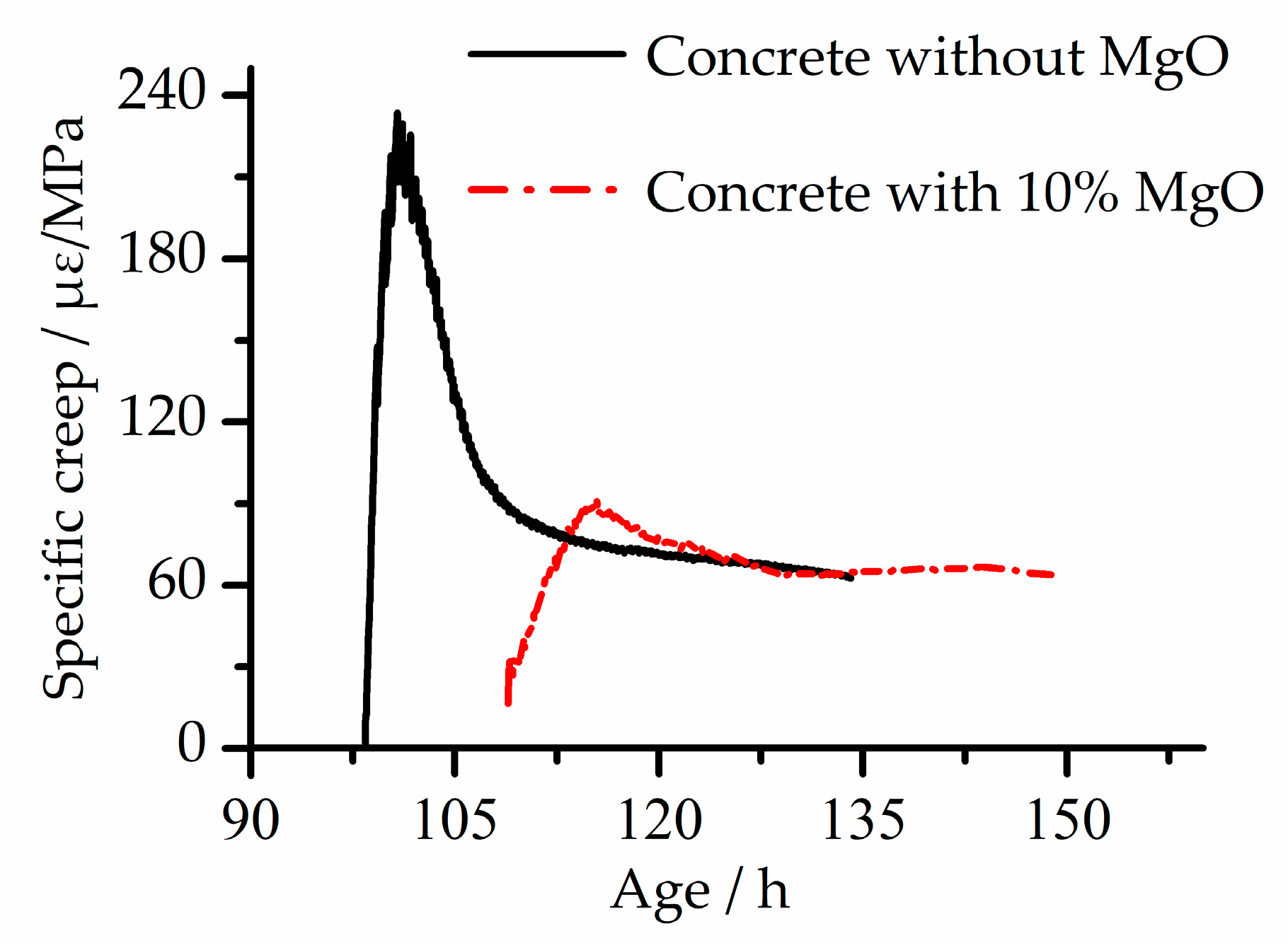



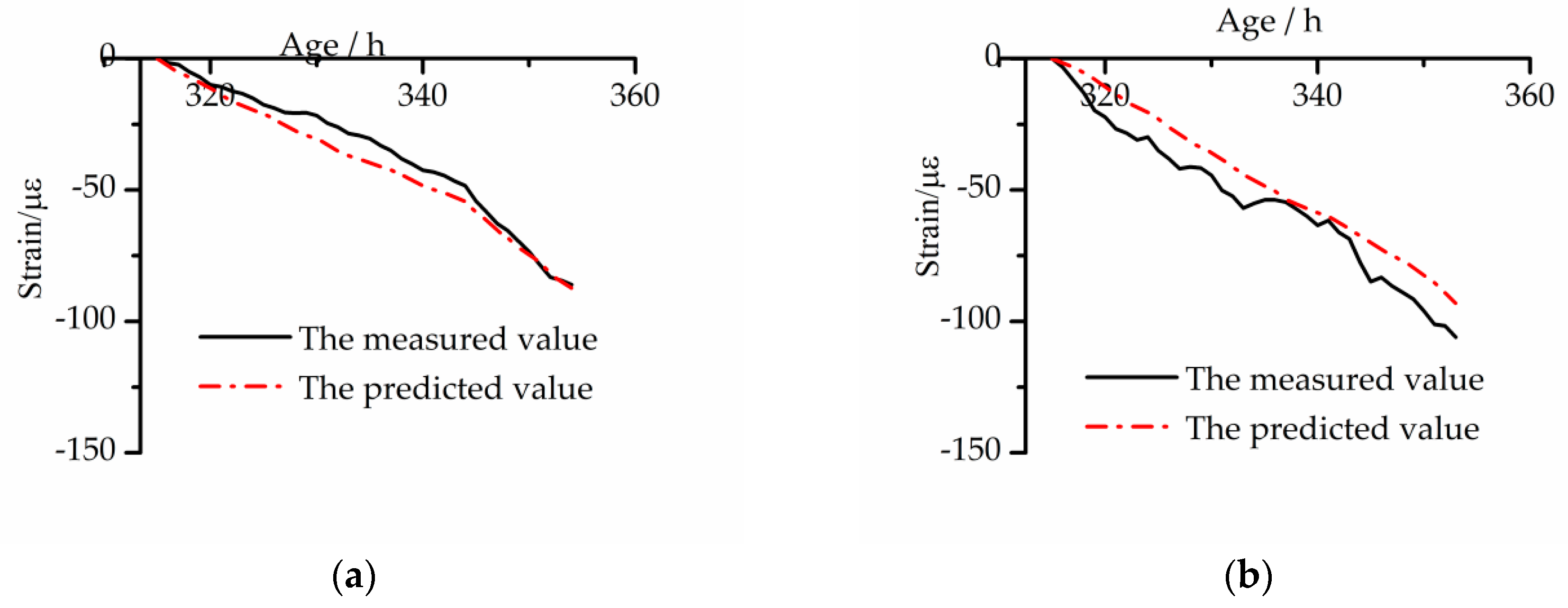
| Specimen | Unit Content (kg/m3) | ||||||||
|---|---|---|---|---|---|---|---|---|---|
| Water | Cement | Fly Ash | MgO | Sand | Gravel (mm) | Water-Reducing Agent | Air-Entraining Agent | ||
| 5–20 | 20–40 | ||||||||
| BC | 120 | 188 | 63 | 0 | 768 | 541 | 661 | 1.506 | 0.0100 |
| EC | 120 | 188 | 63 | 12.5 | 763 | 537 | 657 | 1.750 | 0.0125 |
| CaO | Al2O3 | MgO | SiO2 | Fe2O3 | SO3 | LOI | |
|---|---|---|---|---|---|---|---|
| Cement | 58.62 | 5.23 | 2.05 | 23.21 | 3.70 | 2.78 | 2.44 |
| Fly ash | 5.25 | 28.18 | 0.79 | 46.65 | 5.43 | 0.71 | 3.29 |
| Absorption (%) | MgO Content (%) | LOI (%) | Reaction Time (s) | Setting Time (min) | Compressive Strength (MPa) | |||
|---|---|---|---|---|---|---|---|---|
| Initial | Final | 7 Days | 28 Days | |||||
| M-type MgO | ≤0.3 | ≥80.0 | ≤4.0 | ≥100 and <200 | ≥45 | ≤600 | ≥22.5 | ≥42.5 |
| Concrete | Setting Time (h) | Slump (mm) | Air Content (%) | |
|---|---|---|---|---|
| Initial | Final | |||
| BC | 10.3 | 13.4 | 80 | 4.3 |
| EC | 10.9 | 14.4 | 70 | 3.7 |
| Calculation Parameters | BC | EC |
|---|---|---|
| 3 | 6 | |
| 200 | 200 | |
| 300 | 300 | |
| 3 | 3 | |
| 400 | 400 |
| Calculation Parameters | BC | EC |
|---|---|---|
| 3.5 | 6 | |
| 40 | 50 | |
| 300 | 300 | |
| 3 | 3 | |
| 7 × 10−4 | 7 × 10−4 | |
| 1 × 10−5 | 8 × 10−6 |
© 2020 by the authors. Licensee MDPI, Basel, Switzerland. This article is an open access article distributed under the terms and conditions of the Creative Commons Attribution (CC BY) license (http://creativecommons.org/licenses/by/4.0/).
Share and Cite
Zhao, Z.; Zhang, H.; Fang, B.; Sun, Y.; Zhong, Y.; Shi, T. Tensile Creep Model of Slab Concrete Based on Microprestress-Solidification Theory. Materials 2020, 13, 3157. https://doi.org/10.3390/ma13143157
Zhao Z, Zhang H, Fang B, Sun Y, Zhong Y, Shi T. Tensile Creep Model of Slab Concrete Based on Microprestress-Solidification Theory. Materials. 2020; 13(14):3157. https://doi.org/10.3390/ma13143157
Chicago/Turabian StyleZhao, Zhifang, Huanmi Zhang, Bo Fang, Yukun Sun, Yangfeng Zhong, and Tao Shi. 2020. "Tensile Creep Model of Slab Concrete Based on Microprestress-Solidification Theory" Materials 13, no. 14: 3157. https://doi.org/10.3390/ma13143157
APA StyleZhao, Z., Zhang, H., Fang, B., Sun, Y., Zhong, Y., & Shi, T. (2020). Tensile Creep Model of Slab Concrete Based on Microprestress-Solidification Theory. Materials, 13(14), 3157. https://doi.org/10.3390/ma13143157





